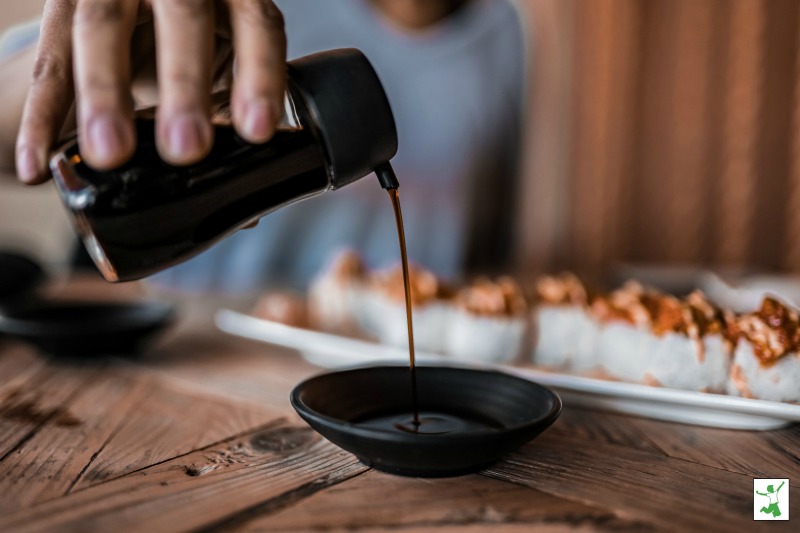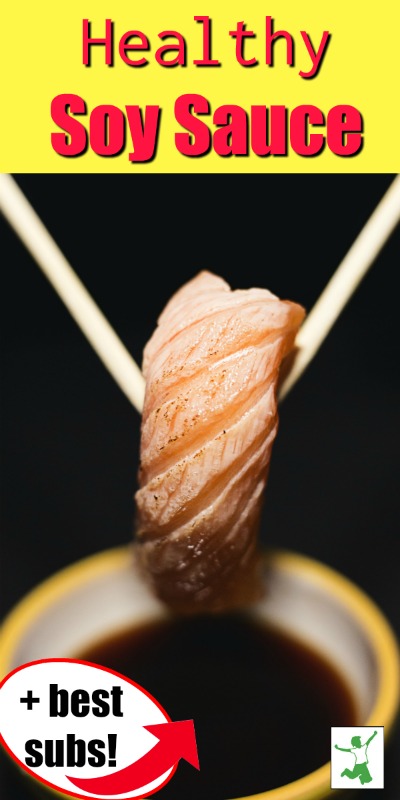What to look for when sourcing healthy soy sauce to obtain all the health benefits from the traditional brewing process and which substitutes are best to use if you are allergic to soy or avoiding grains.

Soy sauce, also commonly known as shoyu, is the best-known flavor enhancer in Asian cooking. Made the old-fashioned way — through a careful fermentation process that can take as long as 18 months — it’s a healthy and nourishing product.
The best quality, truly healthy brands of soy sauce are not only fermented in a traditional manner but also unpasteurized to retain beneficial enzymes and nutritional cofactors.
Tamari is a variant that is made only with soybeans (without any wheat). As far as I know, all the brands of tamari and most brands of shoyu sold in health food stores have been pasteurized. Though not optimal, these are far superior to the commercial soy sauces sold in supermarkets and used by the restaurant industry.
The Scary Truth About Commercial Soy Sauce
The most common soy sauces sold in supermarkets and served at the majority of restaurants are made in two days or less. Here’s how they do it.
If you really love your takeaway, you might want to sit down for this.
Soybean meal and often corn starches are rapidly reduced to their component amino acids using a high-tech process known as “rapid hydrolysis” or “acid hydrolysis”. This involves heating defatted hydrolyzed soy protein with eighteen percent hydrochloric acid for 8 to 12 hours, then neutralizing the brew with sodium carbonate. The result is a dark brown liquid — a chemical soy sauce.
When mixed with some genuine fermented soy sauce to improve its flavor and odor, it is called a “semi-chemical” soy sauce. Sugars, caramel colorings, and other flavorings are added before further refinement, pasteurization, and bottling.
The rapid hydrolysis method uses the enzyme glutamase as a reactor. This creates large amounts of an unnatural form of glutamic acid that closely resembles that found in MSG. In contrast, the production of genuine old-fashioned soy sauce uses the enzyme glutaminase to form naturally occurring glutamic acid.
Other undesirables that appear during chemical hydrolysis are levulinic and formic acids, instead of beneficial lactic acid, and the gas produces dimethyl sulfide, hydrogen sulfide and furfurol from the amino acid methionine. The hydrolysis process also results in the total destruction of the beneficial and essential amino acid tryptophan.
Modern soy sauces may also contain dangerous levels of chemicals known as chloropropanols, which are produced when soy sauce production is sped up using acid hydrolyzation methods. In Great Britain, back in 2001, nearly 25 percent of commercial soy sauces were found to contain dangerous levels of these chemicals, and the products were recalled.
The Australia New Zealand Food Authority also recalled commercial soy sauces for this reason. No recalls occurred in the United States, but because most modern companies use some form of this method and exercise less-than-perfect quality control, the safety of commercial soy sauces cannot be assured.
Researchers have also found furanone in commercial soy sauce. These are mutagenic to bacteria and cause DNA damage in lab tests. Salsolinol, a neurotoxin linked to DNA damage and chromosomal aberrations, Parkinson’s disease, and cancer, has been identified in soy sauce.
Ethyl carbamate — also linked to cancer– is found in commercial samples of soy sauce, light and dark miso and some alcoholic beverages. The maximum concentrations observed were 73 mcg per kg in soy sauce compared to the tiny amount of 7.9 mcg per kg found in miso.
Don’t Use Commercial Soy Sauce if on MAOI Drugs
Soy sauce also contains a high content of the amino acid tyramine, a potent precursor of mutagens produced by nitrites. The tyramine content makes this product unsuitable for people taking monoamine oxidase inhibitors (MAOI) drugs, which are commonly prescribed for depression, migraines, and high blood pressure.
The best-known tyramine rich foods are aged cheeses, red wines, smoked and pickled herring, and beer. Eating any of these foods — including tyramine rich soy sauce — while taking MAOI drugs can bring on an episode of high blood pressure accompanied by severe headache, palpitations, and nausea.
Healthy Soy Sauce
So for truly healthy soy sauce, get the genuine old fashioned fermented raw stuff.
Less optimal but still fine for most people are small amounts of health food store brand, pasteurized tamari, and shoyu.
Best (and worst) Soy Sauce Substitutes
Are you allergic to soy that is fermented or do you avoid grains in general?
Then, the best alternative to soy sauce is coconut aminos. This product is available either fermented or unfermented.
If sensitive to histamines or glutamate, choose unfermented coconut aminos (source).
Avoid Liquid Aminos
Think a liquid aminos soy sauce substitute would be healthier?
Think again!
Liquid aminos are an unfermented liquid soy product invented by health food pioneer Paul Bragg and is a soy sauce alternative preferred by many health aficionados. Its main claim to fame has been a lower sodium content than tamari or shoyu. Given that salt has been unjustly maligned as unhealthy, this may not even be desirable.
In any case, lower-sodium does not mean low, and the company responsible for manufacturing liquid aminos was warned in 1996 by the FDA that it’s “no salt” label was misleading and it’s “healthy” claim was unwarranted given its high sodium levels.
The company was also told to cease and desist using its “No MSG” claim. As a hydrolyzed protein, liquid aminos contain plenty of MSG produced as a residue of the hydrolyzing process. It also contains aspartic acid, another brain-damaging excitotoxin, which is a component of aspartame as well.
The takeaway: No bragging rights for liquid aminos!

More Information
Soy Lecithin: Really So Unhealthy?
Estrogenic Foods Like Soy Trigger Precancerous Breasts
Is Your Egg Allergy Really a Soy Allergy in Disguise?
170 Scientific Reasons to Eliminate Soy from Your Diet
Soy Formula is Harmful to a Child’s Development







I’ve been buying Trader Joe’s soy sauce due to it’s simple ingredient list: water, soybean, wheat, salt and vinegar. Label claims it is made in Japan using natural brewing and fermentation, spread over 6 months to 2 years. Does this sound like a safer choice than regular grocery store sauces?
I buy Trader Joe’s as well. If their label is accurate, it’s a natural product.
Any response to this— regarding choice to use TJ’s Soy Sauce??
How about coconut aminos?
I just might make your recipe! I have to wait until I make some broth though.
Try taking it back where you bought it. They store my just exchanged it for something else since it’s unopened.
South River Miso in Conway, MA makes an amazing Miso Tamari from their Chickpea Miso that is unpasteurized. They also produce several tasty varieties of Seasonal Miso on their Farm. Southriver.com
Sigh….. thanks for sharing, though now I have an unopened bottle of liquid aminos that I don’t know what to do with except through in the trash. :0(
Do a bit more research before you toss your Braggs — the article has some holes.
hi shannon,
i am so curious as to know more about braggs. my children’s school uses so much of it and i have been quite worried about it. i at a big batch of their soup this week and had a wicked migraine, but didn’t attribute it to the braggs. could you please share with me where the holes are in this article, i really would like to know more.
thanks so much
heather
Thanks I have been looking for one.
LK – a huge thank you ! I just remember that I had looked up liquid aminos at some point and saw they were made with soy, I had no idea about coconut aminos.
Read the article.
Substitute with coconut aminos and you don’t have to worry about the “maybe, maybe not”!